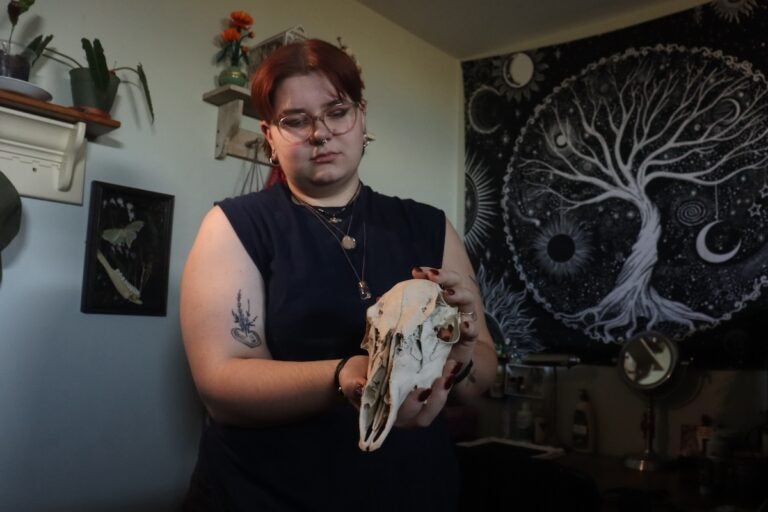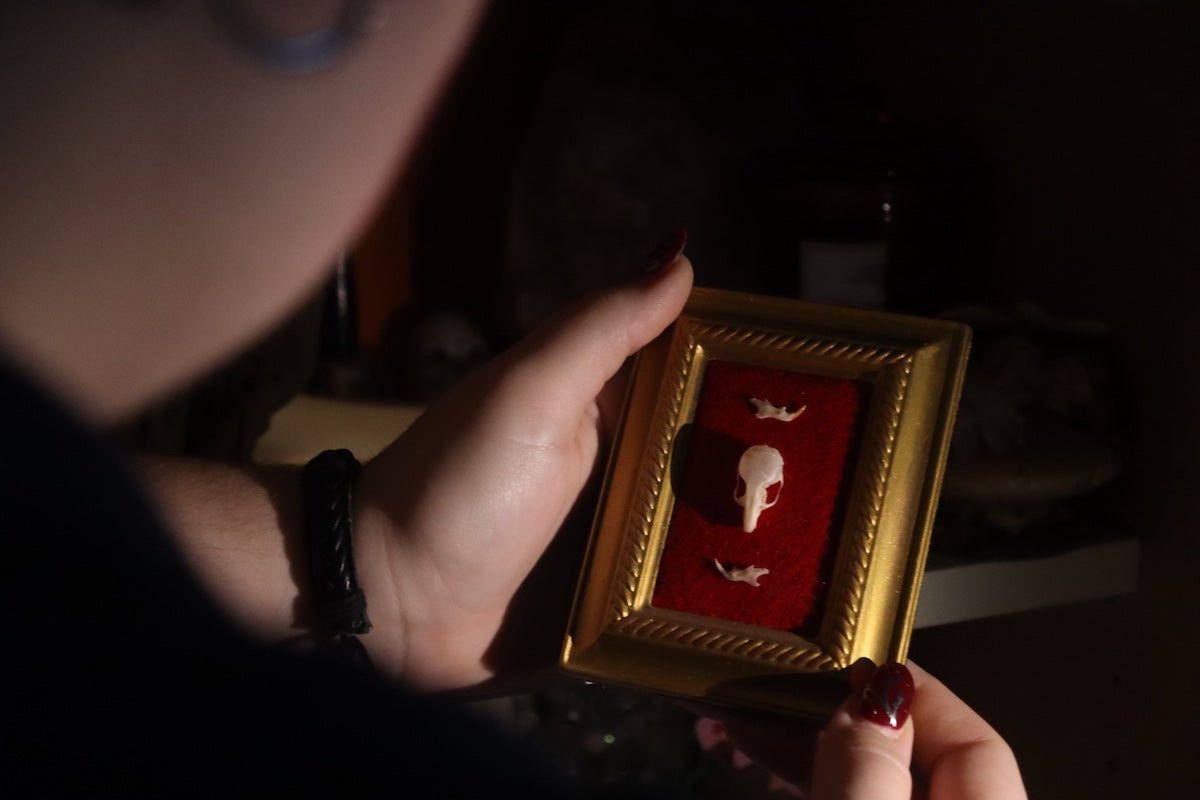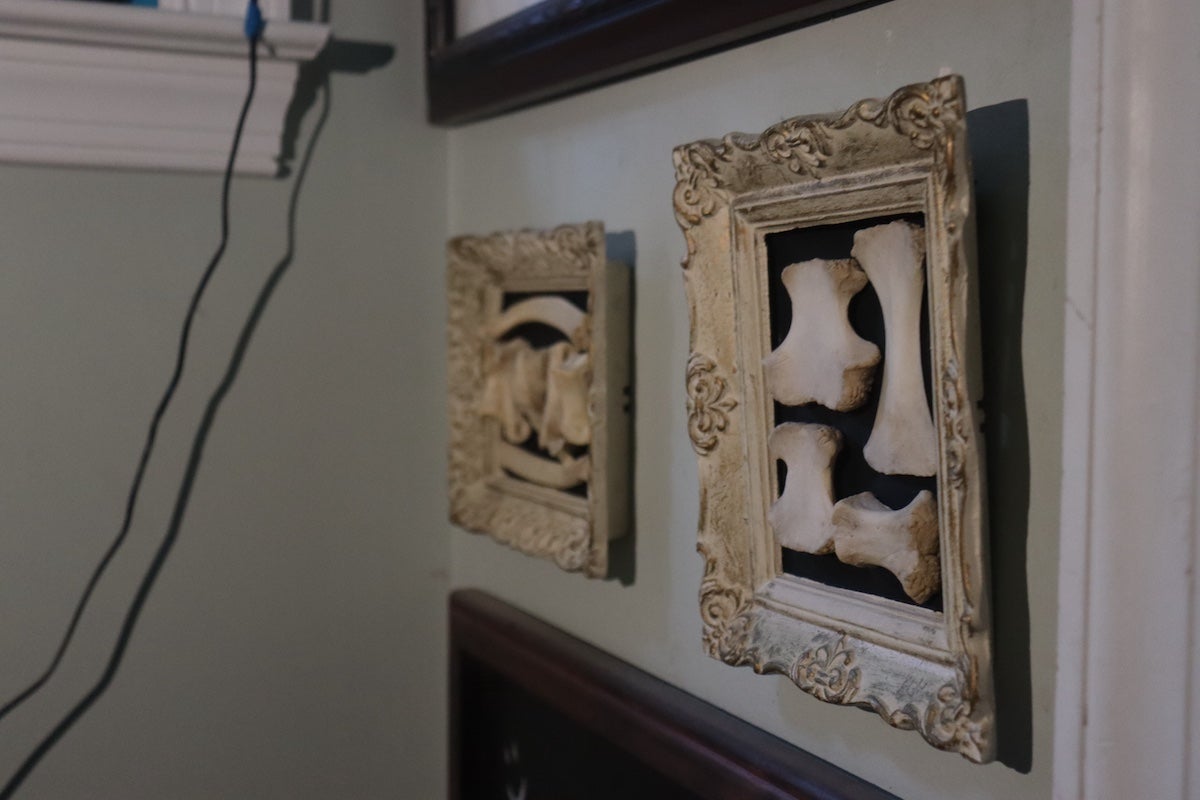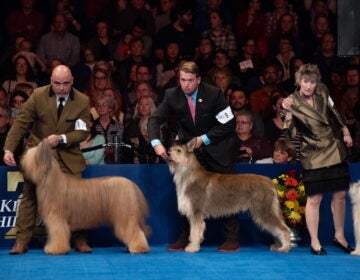Animal skulls and bones get a second life in the art works of Boyertown creator
In Boyertown, PA, artist Charlee Heinz turns bones from forest finds into meaningful artwork that explores death and beauty.

Charlee Heinz collects and cleans animal bones to use them in works of art. (Lise Peet)
It all started when artist Charlee Heinz discovered a deer that had died in the woods. “I already had a slight interest in collecting bones and stuff,” said Heinz. “I waited a year for it to rot away and then stole its bones.” It was Heinz’ first foray into working with bones, something they’ve been doing for three years now.
Recent work includes a section of deer spine positioned in a black frame, artfully surrounded by deer ribs that create a whimsical pattern. In another frame, a jaw bone with teeth sits next to small pieces of fern, dried flowers and a delicate light green luna moth. Another piece features two gleaming white dove skulls, their beaks almost touching, creating a heart shape against a red piece of felt as the backdrop.
Heinz lives in Boyertown, Pennsylvania, and word has gotten out about their work and obsession with bones. Now, friends, family, and coworkers drop off random dead creatures they find.

“Sometimes, I just come home and there will be bones or just bugs on my desk. I came home the one day and there was a bird skull on my desk. And then I came home a couple days later and there was a dead dragonfly on my desk as well,” Heinz said.
Heinz even got bones as a birthday gift. “My mom and dad gave me a box of skulls for my birthday that they got from their one friend’s neighbor. I don’t know where she got them. Apparently she has a lot of bones in her basement or something, but it was two groundhog skulls, two deer skulls, and a little, little cat skull.”
Bones as a medium and inspiration
Heinz has a background in ceramics, and has always preferred physical media that require a series of different processes to make a whole piece.
Learning to process bones was a bit of a learning curve. While Heinz let time take its course with the deer bones in the wood, they’ve had some challenging experiences with bone processing since then. Heinz recalls collecting a bunch of bones that still had a lot of skin and fur on them. They soaked the bones in water in hopes of loosening things up.
“And opening that bucket back up was an awful experience,” said Heinz. “Very rank, very stank. It smelled like rotting flesh — it was really gross. And I avoided it for like two years and left them sitting there because I didn’t want to deal with it.”
The process is much more straightforward when done right, but Heinz says making the bones artwork-ready requires several steps over the course of days.

“When I collect the bones, if they have flesh on them or whatever, they go through a process which is called maceration, you just leave them in a bucket full of water to loosen up all the skin and stuff. And then after that, I rinse them and scrub them off a little bit. You can soak them in water and dish soap, and that’s the degreasing process,” said Heinz.
The dish soap removes fat that can coat the bones as an animal decomposes. “That can make them kind of yellowy, so if you soak them in with the dish soap, it kind of pulls a lot of that fat out of the bones and will make them whiter. And then you put them into a mixture of peroxide and water to whiten them even further.”
After this process, the bones are fur-free, white, and ready to be assembled on felt canvases, picture frames, or jewelry–all which Heinz buys secondhand and customizes themselves. Heinz’ work is stunning, if slightly eerie.
“People should get more into bones. It’s a beautiful way of appreciating the dead.”
Subscribe to The Pulse
WHYY is your source for fact-based, in-depth journalism and information. As a nonprofit organization, we rely on financial support from readers like you. Please give today.






